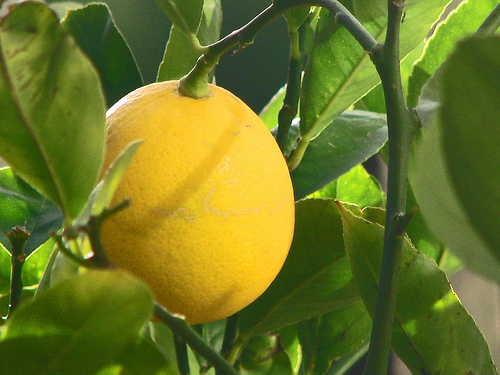Dwarf Citrus Trees for the Small Garden
If you’re new to citrus gardening, consider foregoing the giant standards and planting their dwarf cousins instead

I don’t know about you, but I think if there’s anything as awesome as fresh vegetables from my garden, it’s fresh fruit from my own trees. Oranges and lemons are my favorite fruits to grow—and eat. Plus, they grow on trees that are handsome and evergreen and that add a most heavenly scent to the air when they’re blooming.
Learn more: 6 Tips for Pruning Young Fruit Trees
If you haven’t done any citrus gardening yet but would like to, consider foregoing the giant standards and planting their dwarf cousins instead. When planted in the ground, dwarf citrus trees grow anywhere from 8 to 12 feet tall, and if they’re planted in a large container they’ll remain much smaller.
The only drawback is that many (such as oranges and lemons) won’t do well outdoors year-round much under Zone 9. Still, some citrus (such as mandarins) can take a little bite of frost. If you are below Zone 9, it’s easy to plant citrus into containers and just wheel it into the house for the winter (or under an overhang in semi-mild areas).

Caring for citrus trees
The best way for any fruit tree to become established in a new yard or garden is to purchase them bareroot and get them into the ground while they’re dormant. If you miss that window, you should be able to find some that are already happily growing in containers. They’ll go through a little transplant shock when they’re first planted, as opposed to the barerooted ones that simply “wake up” in the spring, not realizing that they’ve been disrupted at all.
Citrus enjoys full sun and soil that’s full of organic matter. But more important than loamy soil is at least a well-draining one. This is pretty much a requirement for citrus. These trees want evenly moist soil. On the other hand, they’ll end up dead in a constantly soggy area (especially bad in clay types).
I found out the hard way that my citrus trees do best on a regular watering schedule. One summer I did the whole hit-and-miss watering routine and ended up with a lot of split oranges on the tree. What happened is that I let the soil entirely dry out before I watered again—a hard lesson.

Popular citrus trees for the home garden
Listed are some citrus varieties to get you started. In no way is this list exhaustive. In fact, many traditional standard types have been grafted onto dwarf or semi-dwarf rootstocks.
- Lemons—‘Improved Meyer’, ‘Dwarf Lisbon’
- Limes—‘Dwarf Bearss Seedless’
- Oranges—‘Dwarf Campbell Valencia’, ‘Dwarf Washington Navel’
- Mandarin oranges—‘Clementine’, ‘Satsuma’, ‘Dwarf Tango’
- Blood orange—‘Moro’ (semi-dwarf), ‘Smith Red’
- Grapefruit—‘Dwarf Redblush’
- Kumquats—‘Nagami’
Harvesting citrus
Fruit on citrus trees depends on the type of fruit and sometimes the variety. My oranges are almost ever-bearing and have ripe fruit on them the same time they burst into bloom. (Did I mention that I love my orange trees?) Some will ripen during late fall and early winter.
The most important thing to keep in mind before you break out your bushel basket and start plucking the fruit off of your tree is that citrus only ripens while still on the branch. In other words, don’t think in terms of tomatoes (which will ripen further on your window sill); if you harvest a near-ready crop of not-so-sweet oranges, that’s what you’ll be left with. My best citrus harvesting advice is to become familiar with your variety’s harvesting time frame, then pick one off the tree and taste it before harvesting more fruit.
Dwarf citrus trees indoors
If your citrus tree has been soaking up the backyard sun for several months and you’d like to bring it indoors for the winter, it’s best to place it under an overhang for a couple of weeks beforehand. This allows the tree to become accustomed to its new environment gradually. Reverse this process about two weeks before you bring it back outdoors in the spring.
Be sure to place it near a window that has a southern exposure (away from direct heat) so it can soak up the most sun. The next best place would be western exposure, but the more sun exposure you can offer, the healthier the tree and the more fruit it will produce. Citrus want their soil on the acidic side, so use an appropriate fertilizer about every four to six weeks.
I have to admit that I’m pretty lucky to be living in a zone that allows my citrus trees to live outdoors year-round. But that doesn’t stop me from keeping a sweet-smelling Meyer lemon tree as a fruit-producing houseplant indoors as well.
Fine Gardening Recommended Products

A.M. Leonard Deluxe Soil Knife & Leather Sheath Combo
Fine Gardening receives a commission for items purchased through links on this site, including Amazon Associates and other affiliate advertising programs.

Berry & Bird Rabbiting Spade, Trenching Shovel
Fine Gardening receives a commission for items purchased through links on this site, including Amazon Associates and other affiliate advertising programs.

Nothers RooTrimmer 50 Cell, 10pcs
Fine Gardening receives a commission for items purchased through links on this site, including Amazon Associates and other affiliate advertising programs.







Comments
Log in or create an account to post a comment.
Sign up Log in